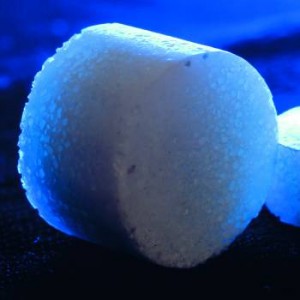
EDUARDO CESARPorous structure helps surgeons fix the surgical jaw prosthesis EDUARDO CESAR
An artificial jaw with the same mechanical characteristics as the original bone, such as resistance, rigidity and flexibility, made from a synthetic material that was innovatively devised by researchers at the University of São Paulo (USP) in São Carlos, upstate São Paulo, was successfully implanted in a cancer patient in November of last year. The synthetic material in the surgical prosthesis is made with polymethylmethacrylate or PMMA, a type of acrylic, reinforced internally with carbon fibers. “The implant is dense internally and porous on the surface and its pores are coated with a bone-growth stimulant,” says Professor Benedito de Moraes Purquerio, coordinator of surgical implants and prostheses research, and development coordinator of the group for bone reconstruction from the Tribology and Composites Laboratory (LTC) at the São Carlos School of Engineering (EESC) at the University of São Paulo (read more about the subject in Pesquisa FAPESP no. 150). The research group had already lodged a patent with the National Institute of Industrial Property (INPI) for the manufacturing process of the porous structure of implants. “The carboxymethyl cellulose gel is the agent that induces the creation of pores on the surface of the material, which are identified by their well-defined dimensional characteristics and by the fact that they are open and interconnected, which supplies the conditions needed for anchoring a bone-growth stimulator,” explains materials engineer Carlos Alberto Fortulan, a member of the LTC research group.
The bone-growth stimulator chosen for coating the pores is hydroxyapatite, the basic mineral in bone composition. The pores of the material vary in size from 50 to 400 micrometers, which is compatible with the bone repair processes. “The holes are a suitable size for the mucus and muscles to penetrate them and bind with the structure, thus stimulating tissue growth,” says surgeon Edelto dos Santos Antunes, head of oral and maxillofacial surgery at the Santa Tereza Hospital in Petrópolis, Rio de Janeiro State, who heads up jaw implants using the new material. “Its flexibility, similar to that of bone, generates electrical stimuli on the surface of the material, which sends a signal to the surrounding tissue, resulting in a field that is suitable for fixing the implant.”
Currently, when there is a need to reconstruct a jaw, the surgeon removes bone from other places in the body and, during surgery, molds the graft, which is fixed with a titanium plate. “Although it’s a bone from the patient, once it’s removed from its original location it loses its living tissue properties and becomes prone to infection and to reabsorption by the organism,” says Antunes. Some months later, as a large part of the implanted bone is reabsorbed by the organism, the result is worse than the situation immediately following the surgery. “This means that there’s no predictability or stability in the result, two key characteristics for success when fully or partially replacing bone with artificial surgical prostheses,” says the surgeon, who did a PhD in mechanical engineering at USP in São Carlos, where his tutor was Professor Purquerio. In other words, over time, significant changes occur in the bone graft originally implanted, often resulting in the need for corrective surgery.

Tribology and Composites Laboratory/USPSurgical jaw prosthesisTribology and Composites Laboratory/USP
“The surgical prosthesis we are developing is tailor-made, copied from the geometry of the bone that’ll be removed,” says Antunes. The process begins with a computerized tomography, from which a three dimensional model is created that reproduces the patient’s face. “With the model produced, by rapid prototyping, a surgical prosthesis is made that is very similar to the bone that has to be replaced,” reports mechanical engineer Jonas de Carvalho, from the LTC. In addition to the esthetic gain, one can forecast the surgery’s outcome.
In the operation performed last year, all the muscles of the jaw that was removed because of a tumor that had entirely destroyed the bone were stitched into the prosthesis. “When the patient woke up after surgery and put her tongue out, she already had all the normal swallowing movements,” reports Antunes. The patient’s fast response was due to using a material with mechanical qualities that are very similar to those of bone, which improves the relationship of the tissue with the implanted material.
Since the surgeon’s main concern in this first implant was to fix the tissue correctly to the prosthesis and the tongue to the new jaw, placement of the teeth was left to a subsequent stage. “We’re preparing other operations in which the prostheses will receive small bone grafts from the patient at strategic points, where the dental implants will be made,” says Antunes. As a result, mastication and the patient’s dental esthetics will be reconstructed. The surgical procedures are performed with the support of the State University of Rio de Janeiro (UERJ), in a partnership with the hospital in Rio de Janeiro.
UERJ and other institutions, such as the Catholic University of Petrópolis, USP in São Carlos, the Renato Archer Research Center in Campinas, which is linked to the Ministry of Science and Technology, and Fluminense Federal University, have joined forces to set up a center at the Santa Tereza Hospital for the treatment of craniofacial deformities and for research. “Over and above research, the aim of this initiative is to train professionals from the engineering area as applied to medicine within all the protocols that we develop with these new materials,” Antunes says. “The advantages of using certified artificial material include reduced surgery and patient recovery times,” he points out. To completely remove the jaw and replace it with a prosthesis made from artificial material takes 2.5 to 5 hours, whereas the traditional bone graft method takes as long as 10 hours, on average.
Republish